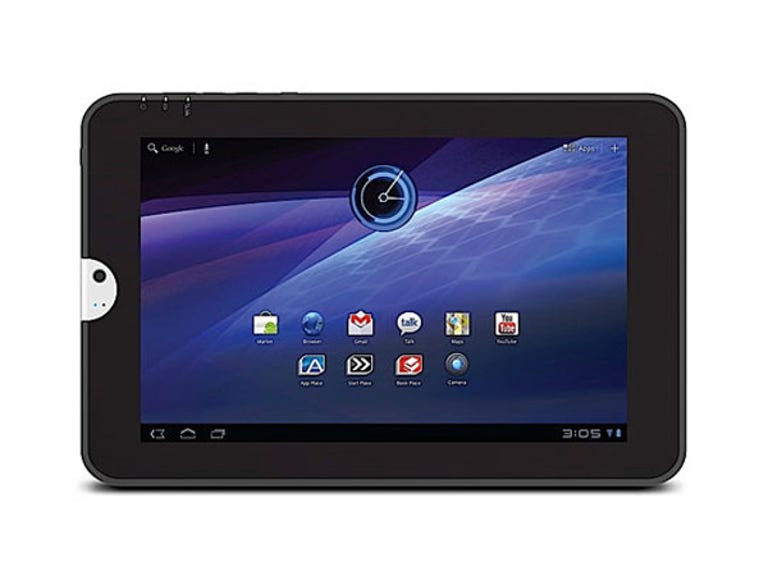 Why You Can Trust CNET
Why You Can Trust CNET Toshiba AT100 review: Toshiba Tablet AT100 (Thrive)
The Toshiba Tablet AT100 "Thrive" is, well, not very vibrant. It does offer options that no other Android tablet does, but the base unit has a poor display and can't store large files.
Toshiba's tablet has gotten people interested due to one thing: full-sized ports. USB and HDMI is available without the need for dongles, and there's a full-sized SD card reader as well, making this quite the attractive proposition on paper. There's a mini-USB port for file transfer (and like all tablets, not for charging), a 3.5mm audio jack, and a docking port at the bottom. The HDMI and USB ports are covered by an annoying dangling rubber cover, and the docking port by a rubber cover that's not even attached and easily lost.
The Good
The Bad
The Bottom Line
The AT100 also has a removable, rubberised back cover that can be bought in different colours for an extra AU$29.95. Behind that cover is a battery that Toshiba plans to sell extras for at AU$79.95 a pop, making this the first tablet we've seen that allows the user to carry an extra battery.
At the time of writing it's running Android 3.01, but it's expected to make the leap to 3.1 some time in July, meaning USB-host capability, decent task switching and a few other bells and whistles are out of reach for now. It comes with 16GB internal storage, a 1GHz ARM 7 processor and 1GB RAM, 5MP rear and 2MP front cameras (with no flash on either), and sells for a rather appealing AU$579.
Or at least appealing at first.
Despite the ruggedised back cover, the AT100 feels cheap to hold, and this isn't helped by the poor quality screen. It's not TN at least (we're guessing VA), but there's a general yellow cast, making whites a more dirty yellow, and we observed a little green fringing around the whites whenever graphics were in motion. We're also wondering if there's a colour-restricted palette in operation, as gradient banding was significantly more obvious than on Asus' or Motorola's tablets. Toshiba tells us there'll be a display driver update coming with 3.1, but whether that will fix these issues remains to be seen.
There's haptic feedback, but is used sparingly, mostly on the back and home keys. It also only supports four simultaneous touches, compared to the Asus Transformer's 10. The camera is placed on the left-hand side, which might make sense for portrait-style video-conferencing, but makes no sense for the back-facing camera where the most comfortable position has you covering it with your hand.
Toshiba's bundled Hancom's ThinkFree Office suite to handle Word, PowerPoint and Excel docs, a trial (yes, crapware is infecting tablets now too) of Norton Security, Amazon's Kindle app, TuneWiki, its own software update app, Evernote, a file manager, PrinterShare, and Toshiba's own media player, which can stream from a DLNA device, or make one DLNA device stream to another. It's bundled in its own video and audio enhancement technology too.
Accessories are rife, with the aforementioned batteries and back covers, as well as a soft neoprene cover, a foldable hard shell cover (AU$49.95), and a dock with two USB ports and an HDMI port ($AU89.95).
Getting our 5.7GB test video file on to the AT100 proved an exercise in frustration. Unlike the Xoom and Eee Pad Transformer, the AT100 suffers from file size limitations.
At this point in time the AT100 only supports FAT file systems for external storage — don't expect NTFS support like the Asus Transformer — Asus has paid for a licence to use the file system in this circumstance. No problem we thought, ExFAT should do fine, then we'll copy to internal storage.
It wasn't to be. Toshiba's own file manager app conked out at the 2GB limit, while Astro File Manager did a more admirable job at 4.10GB before coming up with an error, complaining that the file was too large. After leagues of frustration we gave up, and simply ran our movie directly from the SD card.
Running the DVD-quality XviD file at full screen showed the battery to last four hours and 40 minutes, about typical for an Android device of this size. Of course, thanks to the user swappable battery, this number is as extendible as you need it to be, depending on the size of your wallet.
Toshiba's tablet attempt is admirable for its accessories and full-sized ports, but the base unit falls short with a poor display and the inability to store large files on the internal memory. Maybe these issues will be fixed come the 3.1 update, and we'll be more than happy to revisit the AT100 then. Until that point in time, you should direct your attention to the Eee Pad Transformer for Android tablet love, and make do with some cable converters.


